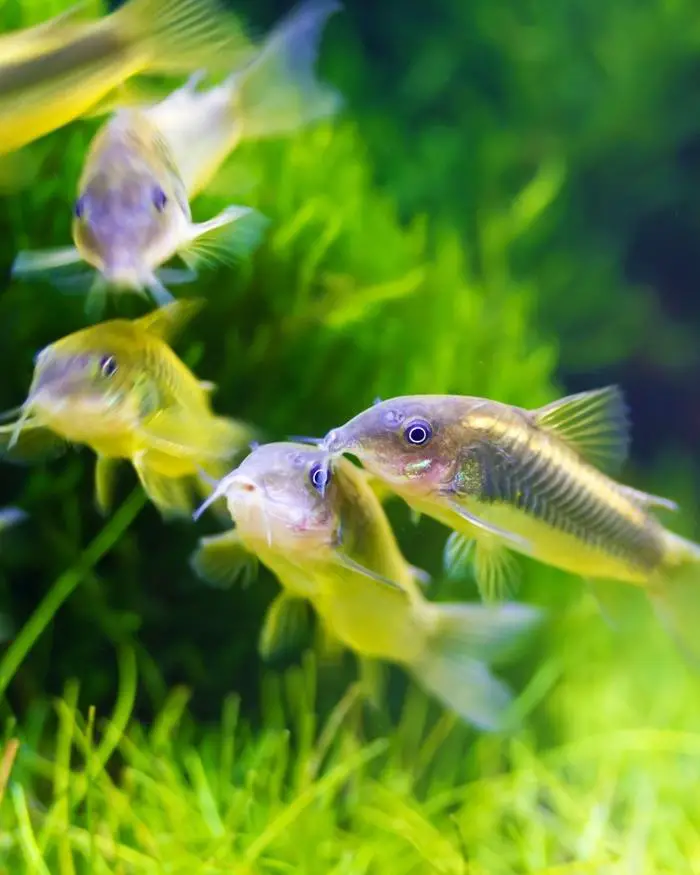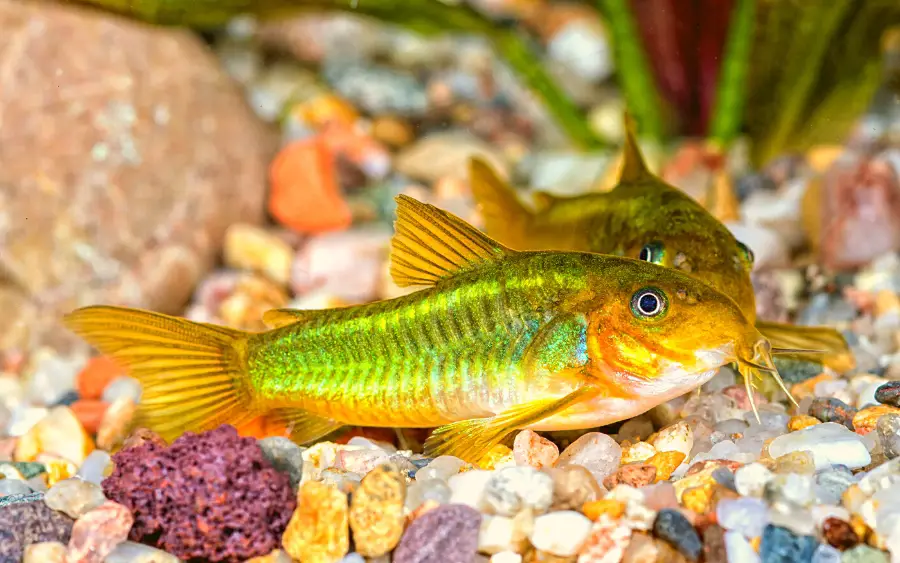If you’re an aquarium hobbyist and have recently bought Cory Catfish, telling the difference between Male vs female Cory Catfish isn’t always easy. However, it’s important to understand their gender differences, especially if you plan to breed them or keep them in groups.
Understanding male vs female Corydoras gender differences goes beyond mere curiosity—it plays a crucial part in maintaining a harmonious aquarium environment and ensuring the well-being of your friends.
This comprehensive guide will show you how to distinguish between male and female Cory Catfish with a 99.9% accuracy rate. You’ll learn about their physical differences, behaviors, and much more.

In this ultimate guide, we will dive deep into the world of Cory Catfish, exploring the key characteristics that set males and females apart. From physical attributes to behavioral cues, we’ll provide you with the tools you need to identify the gender of your Cory Catfish confidently.
Get ready to unlock the secrets and embark on an exciting journey of discovery!
Table of Contents
ToggleIs My Cory Catfish Male or Female?
Determining the sex of a Corydoras catfish (Cory catfish) can be challenging without visual examination or detailed information about the fish’s characteristics. However, a few general guidelines can help you make an educated guess.

These are general guidelines, and the accuracy of sex determination can vary among different species of Corydoras. Additionally, some species exhibit more pronounced sexual dimorphism than others, making distinguishing between males and females easier.
Suppose you’re still uncertain about the sex of your Cory catfish. In that case, I recommend consulting a knowledgeable aquarist or fish expert who can visually examine the fish and provide a more accurate assessment.
Understanding Cory Catfish
Cory Catfish, scientifically known as Corydoras, are popular aquarium fish for their playful and peaceful nature.
These small fish are compatible with many tank mates and thrive in slightly cooler water conditions. Cory Catfish are known for their fan-shaped pelvic fins, which make them easily distinguishable from other species.
How to Determine the Sex of Corydoras Catfish?
Determining the sex of Cory catfish can be challenging as they lack clear external sexual dimorphism. However, there are a few subtle indicators that can help. Male’s body tend to be smaller and slimmer than females, while females are usually larger and have a rounder body shape.
On average, males tend to possess longer and more robust pectoral fins than females. In certain Corydoras species, the discrepancy in size between male and female fins can be quite evident, with males having fins approximately twice as large.
However, in other species, the dissimilarity in fin size may be less noticeable or even absent altogether, making it challenging to see the difference visually.
Another key characteristic is the shape of the ventral fins. Males have longer, more pointed ventral fins, which they use during courtship and breeding.
Additionally, during breeding season, females may appear plumper due to the presence of eggs. Despite these indicators, sexing Cory catfish with certainty can often require closer examination and comparison of multiple individuals.
Male vs Female Cory Catfish Physical Differences
Examining their physical characteristics is one of the most credible ways to differentiate between male and female Cory Catfish. Here’s what to look for:
– Size Difference
Fully grown female Cory Catfish are generally larger than the males. This size disparity is more pronounced when they are ready to lay eggs.
– Body Shape
Females tend to have a plumper and rounder belly, especially when carrying eggs. Males, on the other hand, have a sleeker and more streamlined body.
– Anal Fin
Another noticeable difference between male and female Cory catfish difference is the anal fin. The anal fin is often slightly longer and pointed in males, while in females, it is shorter and rounder.
– Dorsal Fin
The dorsal fin of male Cory Catfish is narrower compared to females, which have a wider dorsal fin.
– Pectoral Fins
Males may have slightly longer and more pointed pectoral fins than females.
– Ventral Fins
While it can be challenging to see, the ventral fins of males are often thicker and more muscular than those of females.
– Color Dimorphism
In some species, like the Panda Cory, males may exhibit more vibrant colors than females, making them easier to identify.
Cory Catfish Male Vs Female Behavioral Differences
Apart from physical distinctions, male and female Cory Catfish may display different behaviors that can help you tell them apart:
– Mating Behavior
Males are known to chase females during the breeding season. If you observe that female fish is pushing the male, it’s a strong indicator of their gender.
– Feeding Habits
Females tend to be slightly fatter, especially when carrying eggs. They may appear more plump during feeding.
– Time Since Purchase
If you’ve recently bought Cory Catfish, their full physical characteristics might take some time to develop. Be patient and keep an eye on them.
Keeping Cory Catfish in Groups
Cory Catfish are social creatures and are best kept in groups. When housed together, they often swim head to tail, forming a unique formation. If you notice this behavior, it’s a good sign that you have male and female Cory Catfish in your aquarium.
At What Age Can You Sex Corydoras?
Corydoras are typically sexually mature at around 9-12 months old. This is when the physical differences between males and females become more pronounced.
The most common way to sex Corydoras is by looking at their size. Females are typically larger and rounder than males. Males are also more slender and have more pointed fins.
Some species of Corydoras also show color dimorphism, meaning that the male and female corys have different coloration. For example, in the Corydoras paleatus species, the males have a more pronounced black stripe on their back than the females.
However, it can be difficult to sex Corydoras accurately, even in mature fish. This is because the physical differences between males and females can be subtle, and some species of Corydoras do not show much sexual dimorphism.
If you are unsure of the sex of your fry Corydoras, it is best to wait until they are fully mature before trying to sex them.
Here are some tips for sexing Corydoras:
- Look at the size and shape of the fish. Females are typically larger and rounder than males.
- Look at the fins. Males have more pointed fins than females.
- Look for color dimorphism. Some species of Corydoras have different coloration between males and females.
- If you are unsure, wait until the fish are fully mature before trying to have sex with them.
Is it Better to Keep Male or Female Corydoras?
Whether keeping male or female Corydoras is better depends on your preferences and goals.
Male corydoras are typically smaller and more slender than females. They may also have more colorful fins. Male corydoras are more likely to be aggressive towards each other, especially during breeding season. However, they can also be more active and playful than females.
Female corydoras are typically larger and more plump than males. They have rounder anal fins, which help attach their eggs to plants during spawning. Female Corydoras are less likely to be aggressive towards each other than males. However, they may be less active and playful than males.
Here is a summary of the pros and cons of keeping male and female Corydoras:
Male corydoras:
- Pros: More colorful fins, more active and playful
- Cons: More likely to be aggressive towards each other, especially during breeding season
Female corydoras:
- Pros: Less likely to be aggressive towards each other, more peaceful
- Cons: Less colorful fins, less active and playful
Overall, there is yet to be a definitive answer to whether keeping male or female corydoras is better. It depends on your personal preferences and goals.
Male corydoras may be a good choice if you are looking for colorful and active corydoras. However, female corydoras may be a better choice if you are looking for peaceful fish and are less likely to be aggressive.
Here are some additional things to consider when deciding whether to keep male or female corydoras:
- Breeding: If you are interested in breeding Corydoras, you must keep both males and females.
- Tank size: Corydoras are shoaling fish, so keeping them in small groups of at least six individuals is best. If you are keeping a large group of corydoras, keeping more females than males may be better to reduce the risk of aggression.
- Other tank inhabitants: If you are keeping other fish in your tank, such as aggressive fish, keeping more females than males may be better to reduce the risk of aggression.
Ultimately, the best way to decide whether to keep male or female corydoras is to consider your personal preferences and goals.
Commonly Asked Questions about Sexing Male and Female Corydoras (FAQs)
How can I tell the gender of my Cory Catfish?
You can distinguish between Male vs female Corydoras by examining their size, body shape, fin characteristics, and behavior. See the guide above for detailed information.
Are male or female Cory Catfish better for a community tank?
Both male and female fish are suitable for community tanks, as they are peaceful and social.
How can I encourage my Cory Catfish to breed?
To encourage breeding, provide your Cory Catfish with a comfortable environment, including plants and hiding spots. Maintain clean water parameters and ensure a balanced diet.
Do all species of Cory Catfish show the same gender differences?
No, gender differences may vary slightly between different species of Cory Catfish. It’s essential to familiarize yourself with your species’ specific characteristics.
Can Cory Catfish change gender?
No, Cory Catfish do not change gender once their gender is determined.
Should I keep Cory Catfish in single-sex groups?
Keeping Cory Catfish in mixed-sex groups is recommended for their well-being and social behavior.
Final Thoughts
In conclusion, Distinguishing between female vs male Cory Catfish can be a rewarding experience for aquarium hobby enthusiasts. You can maintain a healthy and harmonious community in your aquarium by paying attention to their physical differences, behaviors, and interactions. Whether you’re a beginner or an experienced hobbyist, understanding the intricacies of these delightful fish adds to the joy of keeping them in your tank.
So, keep an eye on your Corys Catfish, and soon, you’ll be able to identify and appreciate the unique characteristics of each gender. Whether it’s the long and slender body of the Male or the rounder and broader body of the female, observing male vs female Cory catfish physical features can be a fascinating learning experience. So, keep learning, exploring, and enjoying the wonder of your Cory Catfish community.
You might also like
- False Julii Cory Vs Julii Cory: 3 Ways to Spot Them Apart!
- How to Tell If Cory Catfish Eggs Are Fertilized? (Explained)
- How to Tell If Cory Catfish Is Pregnant? (3 Proven Symptoms)
- Do Cory Catfish Lay Unfertilized Eggs: (5 Breeding Hacks)
- How Often Do Cory Catfish Lay Eggs – What You (Should Know)
- Can You Mix Different Types of Cory Catfish? Is It Possible?
- Pregnant Cory Catfish Behavior: (3 WARNING Signs of Trouble)
- 7 Types of Freshwater Catfish for Aquarium: Boost Your Tank Beauty
- Are Albino Cory Catfish Aggressive: 5 Proven Ways to Tame Them!
- Black Venezuelan Cory Catfish 101: a Comprehensive Guide for Beginners!




